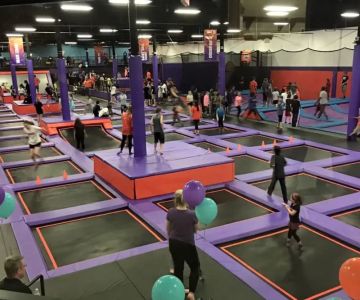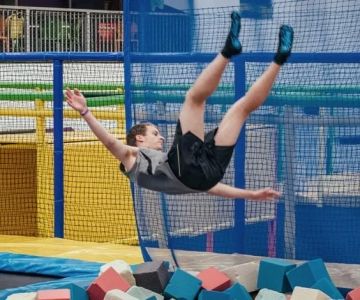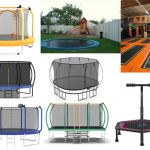- 1-Benefits-of-Trampoline-Speed-Training
- 2-Key-Techniques-for-Using-a-Trampoline-for-Speed-Training
- 3-Incorporating-Trampoline-Workouts-into-Your-Routine
- 4-Real-World-Examples-and-Athlete-Stories
- 5-Finding-the-Best-Trampoline-Products-for-Training
1. Benefits of Trampoline Speed Training
Using a trampoline for speed training offers unique advantages that traditional ground workouts often miss. The trampoline’s elastic surface creates an environment that reduces joint impact, allowing athletes to perform high-intensity speed drills with less risk of injury. This low-impact nature is especially beneficial for individuals recovering from injuries or looking to minimize wear and tear during intense training cycles.
Beyond safety, the trampoline enhances muscle activation, particularly in the calves, quadriceps, and core, by forcing your body to stabilize with each bounce. This instability strengthens fast-twitch muscle fibers crucial for quick bursts of speed. Additionally, the rebound effect improves neuromuscular coordination, helping athletes fine-tune their balance and reaction time.
These combined effects make trampolines an excellent tool not only for sprinters but also for sports requiring explosive speed, such as soccer, basketball, and tennis.
2. Key Techniques for Using a Trampoline for Speed Training
2.1 High-Knee Bounces
High-knee bounces simulate sprinting motions on the trampoline surface. Focus on driving your knees upward while maintaining quick, light foot contacts. This drill improves hip flexor strength and reinforces proper running form without the hard ground impact.
2.2 Bounding Jumps
Bounding involves large, controlled leaps across the trampoline, which build explosive leg power and stride length. The trampoline’s rebound provides extra airtime, allowing athletes to practice powerful push-offs and improved leg extension.
2.3 Lateral Speed Drills
Incorporating side-to-side jumps on the trampoline develops agility and lateral quickness. This helps athletes better handle rapid directional changes common in many sports, all while challenging the stabilizer muscles.
2.4 Quick-Footwork Series
Fast, repeated foot taps on the trampoline surface promote rapid muscle firing and coordination. These drills mimic the quick turnover needed in sprinting and help refine foot speed and balance.
3. Incorporating Trampoline Workouts into Your Routine
Integrating trampoline training requires thoughtful scheduling to complement other workouts and avoid overtraining. Begin with short sessions, around 10-15 minutes, focusing on technique rather than duration. Gradually increase intensity as your body adapts.
3.1 Warm-Up and Cool-Down Considerations
Use the trampoline for dynamic warm-ups like gentle bounces and mobility drills to prepare muscles and joints for speed work. Post-workout, light bouncing can serve as an active recovery to reduce muscle soreness.
3.2 Balancing with Traditional Training
While trampolines are excellent for speed training, they should complement—not replace—running drills on solid ground. This balance ensures athletes develop the full range of muscle strength, coordination, and proprioception needed for peak performance.
3.3 Safety Tips
Always ensure the trampoline surface is well-maintained and clear of obstacles. Beginners should train with supervision or spotters to prevent falls. Wearing supportive athletic shoes and starting on a smaller rebound intensity can minimize injury risk.
4. Real-World Examples and Athlete Stories
A notable example is track athlete Jake, who struggled with shin splints during traditional sprint training. After incorporating trampoline speed exercises, he not only recovered faster but improved his 100-meter dash times by focusing on explosive bounding and high-knee bounces on the trampoline. His story underlines how trampoline training can be a game-changer for athletes facing impact-related challenges.
Similarly, a collegiate soccer team integrated lateral speed drills on trampolines into their regimen. Players reported improved agility and faster direction changes during matches, attributing their on-field success partly to this unconventional training method.
Such real-life cases reinforce the practical benefits of using a trampoline for speed training, especially when paired with proper technique and consistent practice.
5. Finding the Best Trampoline Products for Training
Choosing the right trampoline is essential to maximize the benefits of speed training. Look for models with sturdy frames, high-quality springs or bungee systems, and ample jumping surface to allow for diverse drills. Safety features such as padded edges and enclosure nets are crucial for confidence during intense workouts.
For those interested in exploring top-tier options, visiting Trampoline Zone offers a curated selection of trampolines designed specifically for training purposes. Their expert guidance helps you find products that suit your athletic goals and budget, ensuring you invest in equipment that supports your performance journey.







 Pump It Up Lake Forest Kids Birthday and More4.0 (280 reviews)
Pump It Up Lake Forest Kids Birthday and More4.0 (280 reviews) Urban Air Trampoline and Adventure Park4.0 (349 reviews)
Urban Air Trampoline and Adventure Park4.0 (349 reviews) Church Street Plaza4.0 (731 reviews)
Church Street Plaza4.0 (731 reviews) Fun City Adventure Park3.0 (162 reviews)
Fun City Adventure Park3.0 (162 reviews) Riki Tiki's Indoor PlayGround4.0 (35 reviews)
Riki Tiki's Indoor PlayGround4.0 (35 reviews) Urban Youth Park - South Bay4.0 (107 reviews)
Urban Youth Park - South Bay4.0 (107 reviews) Are Trampoline Parks Safe for Kids? Essential Guide for U.S. Parents
Are Trampoline Parks Safe for Kids? Essential Guide for U.S. Parents How Often Should You Replace Trampoline Springs? Tips for Proper Maintenance
How Often Should You Replace Trampoline Springs? Tips for Proper Maintenance How Much Is a Trampoline? A Detailed Guide to Trampoline Costs and Buying Tips
How Much Is a Trampoline? A Detailed Guide to Trampoline Costs and Buying Tips Bounce Techniques for Stronger Legs: Effective Exercises and Tips
Bounce Techniques for Stronger Legs: Effective Exercises and Tips Essential Music Gear for Trampoline Dance: Complete Guide
Essential Music Gear for Trampoline Dance: Complete Guide Fun STEM Experiments Using Trampolines to Spark Curiosity and Learning
Fun STEM Experiments Using Trampolines to Spark Curiosity and Learning